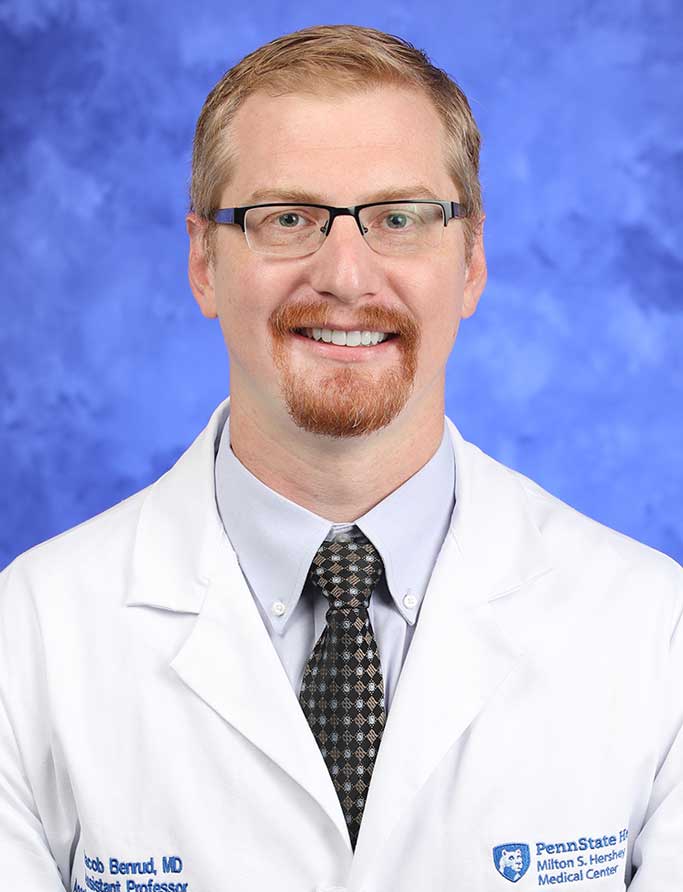Jump to topic
Search
Program Details
Candidates for the Anesthesia/Pain Medicine Fellowship must be diplomates in good standing of the ABPMR, ABA or ABPN and apply for subspecialty certification through their respective boards. Diplomates of other ABMS member boards may apply for certification in pain medicine through their board if their board becomes a co-sponsor of the Pain Medicine Examination.
Penn State Health’s Pain Medicine Center utilizes a multidisciplinary, comprehensive approach to manage more than 7,000 outpatient visits per year.
Fellows will spend nine four-week blocks in the Pain Medicine Center. This rotation exposes the fellow to a wide variety of chronic pain conditions and is the true core of the fellowship program. The full spectrum of currently accepted interventional pain management procedures are performed under direct supervision of the faculty. Additionally, an interventional pain management course on an injection phantom occurs in the beginning of the academic year that decreases the learning curve for fluoroscopically guided injections. Early on in their training, fellows are involved in evaluation and treatment of chronic pain patients who are referred to the pain center by both primary care physicians as well as specialists from various fields of medicine.
Our patients are offered a variety of interventional pain procedures including spinal cord stimulator trials and implants, minimally invasive lumbar decompression, sacroiliac joint fusion interspinous spacer implants, peripheral nerve stimulation, dorsal root ganglion stimulation, epidural steroid injections, radiofrequency ablation, sacroiliac joint injections, peripheral nerve blocks, and others.
The strong didactic program consists of weekly lectures, monthly journal clubs, case presentations, monthly spine rounds, two annual OSCEs with simulation, interventional sessions with simulation, fluoroscopic case presentations, quarterly multidisciplinary patient comfort conferences and daily patient-related teaching.
Fellow education is centered on three major areas:
- Acquiring comprehensive knowledge of diagnosis and treatment of the more chronic pain conditions
- Becoming proficient with a wide variety of interventional pain management procedures
- Providing an overview of the information required to become a consultant in pain management and preparing for the subspecialty board examination
Fellows are on home call one week in four, on average. During call, the fellows will be exposed to consultative care of inpatients with chronic pain conditions. In addition, they will work with regional anesthesia teams.
Learn More about the Fellowship
The program accepts applications only through ERAS.
Virtual Tour
Penn State Health
Penn State Health is an integrated academic health system serving patients and communities across 15 counties in central Pennsylvania. It employs more than 20,900 people systemwide.
The system includes Penn State Health Milton S. Hershey Medical Center, Penn State Health Children’s Hospital and Penn State Cancer Institute based in Hershey, Pa.; Penn State Health Hampden Medical Center in Enola, Pa.; Penn State Health Holy Spirit Medical Center in Camp Hill, Pa.; Penn State Health Lancaster Medical Center in Lancaster, Pa.; Penn State Health St. Joseph Medical Center in Reading, Pa.; Pennsylvania Psychiatric Institute, a specialty provider of inpatient and outpatient behavioral health services, in Harrisburg, Pa.; and 2,417 physicians and direct care providers at 225 outpatient practices. Additionally, the system jointly operates various healthcare providers, including Penn State Health Rehabilitation Hospital, Hershey Outpatient Surgery Center and Hershey Endoscopy Center.
In 2017, Penn State Health partnered with Highmark Health to facilitate creation of a value-based, community care network in the region.
Penn State Health shares an integrated strategic plan and operations with Penn State College of Medicine, the University’s medical school. With campuses in State College and Hershey, Pa., the College of Medicine boasts a portfolio of more than $150 million in funded research and more than 1,700 students and trainees in medicine, nursing, other health professions and biomedical research.
Learn more about Penn State Health

Penn State Health Children’s Hospital (left), Penn State Health Milton S. Hershey Medical Center (center) and Penn State Cancer Institute (right)
Penn State Health Milton S. Hershey Medical Center
500 University Dr., Hershey, Pa., 17033 (Derry Township, Dauphin County)
- The health system’s 611-bed flagship teaching and research hospital
- The only medical facility in Pennsylvania accredited as both an adult and a pediatric Level I (highest-level) trauma center
- Dedicated surgical, neuroscience, cardiovascular, trauma and medical intensive care units
- Accredited Life Lion critical-care transport providing more than 1,100 helicopter and approximately 750 ground ambulance transports per year
- More than 1,300 faculty members and more than 650 residents and fellows
- Approximately 29,000 admissions, 73,000 emergency department visits, 1.1 million outpatient visits and 33,000 surgical procedures annually
- Designated as a Magnet hospital since 2007
Learn more about Milton S. Hershey Medical Center
Penn State Health Children’s Hospital
600 University Dr., Hershey, Pa. 17033 (Derry Township, Dauphin County)
- An eight-story, 263,000-square-foot-facility built in 2013 and expanded in 2020
- 160 licensed pediatric beds, 26-bed pediatric intensive care unit and a 56-bed neonatal intensive care unit
- Level IV (highest-level) neonatal intensive care unit
- Level I quaternary (highest-level) pediatric intensive care unit
- Level I (highest-level) pediatric trauma center designation
- Intermediate care unit
- Dedicated pediatric operating rooms
- More than 150,000 pediatric outpatient visits, 20,000 pediatric emergency room visits, and approximately 5,000 pediatric patient discharges annually
Welcome to Hershey
More About Hershey
Interested in learning more about living and working in Hershey, Pa.? See details here:
Wellness, including emotional, spiritual, social and physical health, is a crucial component to training and to becoming a professional, compassionate and resilient physician. Self-care is a skill which must be continually practiced and reinforced. Penn State College of Medicine and Penn State Health are committed to addressing wellness among residents and fellows, with multiple resources readily available.
Institutional resources
- Visit BeWell – a health program designed to support Penn State Health employees
- See Penn State College of Medicine wellness resources here
- Employee Health Care Concierge and Case Management Service
- Partners in Medicine
Moving to a new city with your family does not have to be stressful. Residency programs have assisted many significant others with finding employment. There is also a GME-Wide Partners in Medicine (PIM) group that offers networking opportunities as well as various social and community oriented activities. - The Doctors Kienle Center for Humanistic Medicine
- Active and easily accessed Office of Professional Mental Health
Graduate medical education resources
Institutional Resources
Penn State Health and Penn State College of Medicine celebrate, embrace and support the diversity of all patients, faculty, staff, students and trainees.
Office for Diversity, Equity and Inclusion
In keeping with this, Penn State Health has an active Office for Diversity, Equity and Inclusion with various programs, networks and resource groups, including:
- Talks and lectures on diversity, equity and inclusion through the Inclusion Academy
- Regular events on topics such as eradicating racism and creating a culture of inclusiveness
- Many Business Employee Resource Groups (BERGs), including:
- Disability Business Employee Resource Group
- Interfaith Business Employee Resource Group
- LGBTQ+ Business Employee Resource Group
- Military and Veterans Business Employee Resource Group
- Multicultural Business Employee Resource Group
- NextGen Business Employee Resource Group
- Black Physician Professional Staff Association – Resource Group
- Hispanic Professional Association
- Asian Physician and Professional Staff Association
- International Workforce Inclusion
- Inclusion Academy
Learn more about the Penn State Health Office for Diversity, Equity and Inclusion
Learn more about the College of Medicine’s Office for Diversity, Equity and Belonging
Office for Culturally Responsive Health Care Education
The vision at Penn State College of Medicine and Penn State Health is to equip learners with the knowledge, skills and attitudes they will need to provide culturally excellent health care and research for an increasingly diverse U.S. population. The Office for Culturally Responsive Health Care Education was formed to help meet that goal.
Learn more about the Office for Culturally Responsive Health Care Education
Office for a Respectful Learning Environment
In addition, the institution does not tolerate discrimination, biases, microaggression, harassment or learner mistreatment of any kind, and any concerns are immediately addressed by the Office for a Respectful Learning Environment.
Learn more about the Office for a Respectful Learning Environment
Network of Under-represented Residents and Fellows
The Network of Under-represented Residents and Fellows (NURF) is a group of diverse residents and fellows representing all specialties. NURF’s goal is to promote cultural diversity in the residency programs through community involvement, mentorship with diverse faculty, professional networking and support for the recruitment of diverse medical students into the residency programs.
NURF is sponsored by the Penn State College of Medicine Graduate Medical Education Office and the Penn State Health Office for Diversity, Equity and Inclusion.
Mailing Address
Penn State Anesthesiology and Perioperative Medicine
500 University Dr., HU32
Hershey, PA 17033
General Contact Information
Fax: 717-531-0950
Curriculum Details
Depending on the fellow’s primary specialty, rotations will take place in the following:
- Spine surgery, where the fellow will participate in the evaluation of patients with spine surgeons and gain an understanding of the surgical options available for patients with pain related to spinal pathology
- Palliative care, with exposure to end-of-life care
- Neuroradiology, which offers a full range of diagnostic and interventional procedures
- Physical medicine and rehabilitation in patients with disabilities resulting from musculoskeletal disorders including spine-related disorders, spinal cord injury, arthritis, trauma and limb amputations
- Acute pain service, with a high volume of epidural and peripheral nerve catheters placed for perioperative pain control
- Psychiatry, where fellows will become familiar with the basics of psychiatric assessment
- Anesthesia, where the fellow will gain experience with airway management, peripheral vascular access, intravenous sedation and management of side effects and complications associated with intravenous sedation
Outside rotations to ACGME-accredited institutions are also available.
Two-week block – anesthesia graduates exempt
During this rotation, the fellows are exposed to a variety of regional anesthesia techniques such as thoracic and lumbar epidural catheters, upper and lower extremity plexus catheters, paravertebral catheters and peripheral nerve catheters, as well as experience in ultrasound-guided procedures.
Fellows will learn the administration of neuraxial anesthesia, including placement of a minimum of 15 thoracic or lumbar epidural injections using an interlaminar technique.
They learn the management of patients in acute post-operative period during daily rounds. There is a strong didactic curriculum including lectures, reading material and discussions. The acute pain inpatient experience is supervised in the assessment and management of inpatients with acute pain. The fellow must document involvement with a minimum of 50 new patients.
The Clinical Competence Committee Evaluation form is used for assessment. The rotation director in charge of the fellow during the elective reports to the fellowship director.
Two-week block – anesthesia graduates exempt
The fellow will learn how to obtain intravenous access in a minimum of 15 patients and basic airway management, including mask ventilation in 15 patients and endotracheal intubation in 15 patients.
The Clinical Competence Committee Evaluation form is used for assessment. The rotation director in charge of the fellow during the elective reports to the fellowship director.
Two-week block
This rotation provides the fellow with an understanding of the surgical options available for patients with pain related to spinal pathology. Fellows also learn a varied perspective on the assessment, diagnosis, and treatment of patients with the most common presenting symptoms to all pain management centers. This rotation could also involve pump implantation exposure with neurosurgery. This rotation may be done with either neurosurgery or orthopedics.
The Clinical Competence Committee Evaluation form is used for assessment. The rotation director in charge of the fellow during the elective reports to the fellowship director.
Two-week block – psychiatry graduates exempt
This rotation provides the fellow with the ability to carry out a complete psychiatric history with special attention to psychiatric and pain comorbidities. The fellow must conduct a complete mental status examination on a minimum of 15 patients, and must demonstrate this ability in five patients to a faculty observer.
The program will provide educational experience in frequent psychiatric and pain co-morbidities, which include substance-related, mood, anxiety, somatoform, factitious and personality disorders. The program will also provide educational experience in the effects of pain medications on mental status. The fellow must understand the principles and techniques of the psychosocial therapies, with special attention to supportive and cognitive behavioral therapies, sufficient to explain to a patient and make a referral when indicated.
The fellow will spend time at Rehab Options, a multi-disciplinary pain rehabilitation program.
The Clinical Competence Committee Evaluation form is used for assessment. The rotation director in charge of the fellow during the elective reports to the fellowship director.
Two-week block – physical medicine and rehabilitation graduates exempt
This rotation provides the fellow with ability to perform a comprehensive musculoskeletal and appropriate neuromuscular history and examination with emphasis on both structure and function as it applies to diagnosing acute and chronic pain problems and developing rehabilitation programs. This will include assessments of static and dynamic flexibility, strength, coordination and agility for peripheral joint, spinal and soft-tissue pain conditions.
Fellows will gain an understanding of the natural history of various musculoskeletal pain disorders and be able to appropriately integrate therapeutic modalities and surgical intervention in the treatment algorithm as well as have an understanding of the indicators and interpretation of electro-diagnostic studies.
Fellows must gain significant hands-on experience in the musculoskeletal and neuromuscular assessment of 15 patients, and demonstrate proficiency in the clinical evaluation and rehabilitation plan development of a minimum of five patients.
The Clinical Competence Committee Evaluation form is used for assessment. The rotation director in charge of the fellow during the elective reports to the fellowship director.
Two-week block
This rotation provides the fellow with a supervised longitudinal experience in an ambulatory and inpatient population that requires palliative care. The experience will include understanding a clinical approach to the multi-dimensional treatments that comprise palliative care, and an understanding of strategies to integrate pain management into this multi-dimensional treatment model.
The fellow must document longitudinal involvement with a minimum of 10 patients who require palliative care.
The Clinical Competence Committee Evaluation form is used for assessment. The rotation director in charge of the fellow during the elective reports to the fellowship director.
Two-week block
This rotation provides the fellow with an understanding of the imaging studies such as MRI, CT scans and X-rays for the diagnosis of spine related disorders. In addition, there may be exposure to discography and kyphoplasty or vertebroplasty.
The Clinical Competence Committee Evaluation form is used for assessment. The rotation director in charge of the fellow during the elective reports to the fellowship director.
OSCE
The Objective Structured Clinical Exam is an examination to test clinical skill performance and competence in skills such as communication in clinical skills during an H-and-P examination as well as during an interventional procedure. Two OSCEs will be conducted within the year.
There will be two stations set up. The first station will be a new patient H-and-P exam with a standardized patient present. The fellow will be given an initial pain assessment form, which has already been filled out by a nurse. One of the faculty will evaluate the fellow’s performance.
The other station will be a procedure. The fellow will talk to one of the faculty as the “patient” as far as introduction and consent, and then talk to the phantom as the “patient” when the procedure starts. One of the faculty will be the voice of the phantom. One of the other faculty will run the fluoro machine, and there will be a nurse present. The fellow will be given the procedure setup form to read prior to entry into the procedure room.
All faculty involved will evaluate the fellows, and results of the OSCE are discussed at the fellow’s next evaluation with the program director.
CRM
Crisis Resource Management training is a three-hour interactive program to provide teams with the skills needed to identify common communication and teamwork problems and, through simulation scenarios, correct or avoid issues. The session includes introduction to the environment and the simulation, two scenarios with a video debrief of performance after each scenario, lecture on the principles of CRM and an evaluation of the program.
Upon completion, the participants should be able to verbalize key concepts of CRM for optimal performance in a crisis, recognize common errors in self and others in a crisis situation, and articulate the application of CRM principles to the work environment and daily life activities.
Fellow Honors and Recognitions
Penn State College of Medicine and Penn State Health Milton S. Hershey Medical Center accept ongoing nominations for the Exceptional Moments in Teaching award.
The award, given monthly by the Office for a Respectful Learning Environment, accepts nominations from College of Medicine students who are invited to submit narratives about faculty members, residents, fellows, nurses or any other educators who challenge them and provide an exceptional learning experience. See more about the award here.
Previous nominees from the Anesthesia/Pain Medicine Fellowship are listed here. Click the + next to a nominee name to read their nominator’s comments.
Latest News from Anesthesiology





